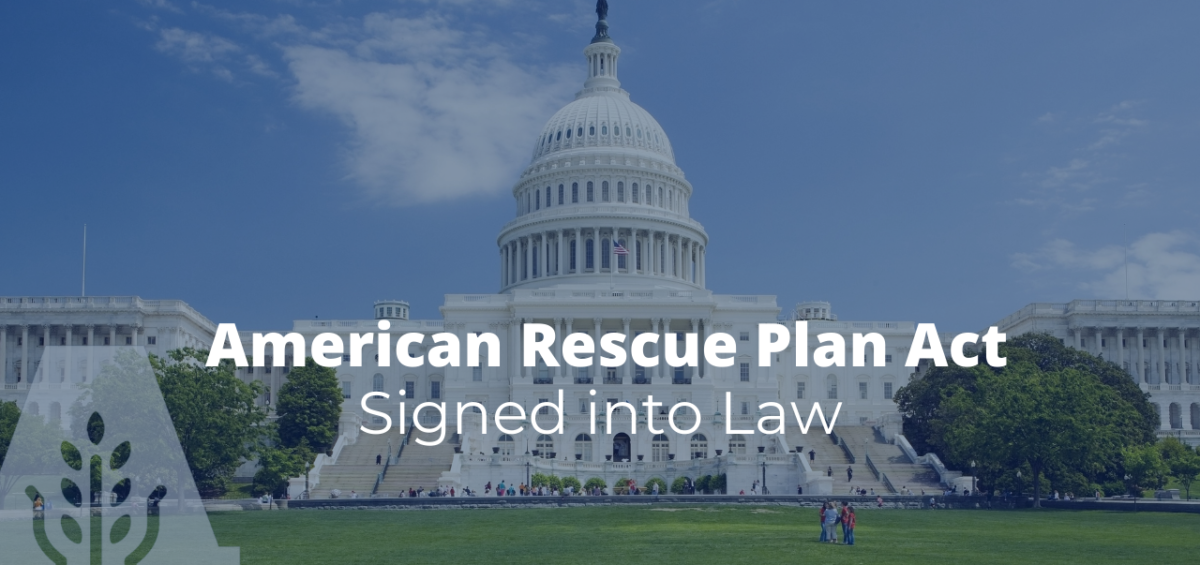The $1.9 trillion American Rescue Plan Act of 2021 was signed into law this week. The law makes an additional $7.25 billion available for the Paycheck Protection Program and expands eligibility to most 501(c) nonprofit organizations. It does not, however, change the program’s March 31 expiration date.
The law also extended the Employee Retention Tax Credit to December 31, 2021 and continued the extra $300 in extra weekly unemployment benefits through September 6, 2021.
Here are some extended details:
Paycheck Protection Program
- Most 501(c) nonprofits will gain access to the PPP
- The “affiliation rules” will be lifted for 501(c)(3) and 501(c)(6) organizations. This means that an organization’s headcount would be considered “per physical location” rather than in-total and across all locations. As such, a 501(c)(3) with more than 500 employees and/or a 501(c)(6) with more than 300 employees-but at multiple locations-would be eligible for PPP.
- An additional $7.25 billion will be made available.
Other Small Business Measures
- $10 billion to expand the State Small Business Credit Initiative to support up to $100 billion in small business financing through state, territorial and tribal governments.
- $15 billion in additional funding for Economic Injury Disaster Loan grants.
- $25 billion for a new “restaurant revitalization” program to offer grants to restaurants and other food and drink establishments.
- $175 million to create a “Community Navigator” program to increase awareness of Small Business Administration (SBA) COVID relief programs.
- $100 million for grants
- $75 million for outreach and education
- $1.25 billion for the shuttered venue operators grant program to provide aid to shuttered live venues.
- $1.33 billion directly to the SBA, mostly in new administrative funding to carry out small business aid and loan programs.
State and Local Aid
- Provides a total of $350 billion in total aid to states, local governments, tribal governments and US territories
- $195.3 billion to states and the District of Columbia
- $130.2 billion to local governments
- $20 billion to tribal governments
- $4.5 billion to US territories
- $10 billion to all for “critical capital projects directly enabling work, education and health monitoring, including remote options, in response to the pandemic.”
Tax and Financial Assistance Measures
- Extends the Employee Retention Credit to December 31, 2021
- Extends the Paid Leave Credit to September 20, 2021 and increases the Credit to $12,000 (up from $10,000) per employee
- Expands the Earned Income Tax Credit for childless adults
- Increases the Child Tax Credit maximum to $3,000 per child ($3,600 per child under the age of 6). From July to the end of 2021, certain taxpayers may receive monthly payments from the Internal Revenue Service
- Temporarily increases the Child and Dependent Tax Credit and makes it fully refundable in 2021
Vaccine, Testing and Other Healthcare Measures
- $47.8 billion for testing and tracing activities
- $11.5 billion to the Centers for Disease Control and Prevention
- $7.5 billion for vaccine distribution, administration, monitoring and tracking
- $1 billion to “strengthen vaccine confidence” and improve rates of vaccination
- $1.75 billion for genomic sequencing, analytics and disease surveillance
- $750 million for global disease detection efforts, global immunization and coordination on public health
- $500 million for public health data surveillance and analytics infrastructure modernization initiatives and to modernize the disease warning system to forecast and track hotspots for COVID, its variants, and emerging biological threats
Unemployment Benefits
- Continues $300 in extra weekly benefits through September 6, 2021
- Makes the first $10,200 in unemployment benefits tax-free in 2020 for taxpayers making less than $150,000 per year
- Fully subsidizes the cost of health insurance premiums for workers through September 30 (i.e., COBRA)
Direct Payments
- Includes another round of stimulus checks of $1,400 for individuals who make up to $75,000 (phased out completely at $80,000) and $2,800 for married couples who make up to $150,000 (phased out completely at $160,000). Eligible taxpayers will also receive an additional $1,400 per dependent. If a taxpayer has not filed their 2020 returns, payments will be determined using 2019 Adjusted Gross Income.












